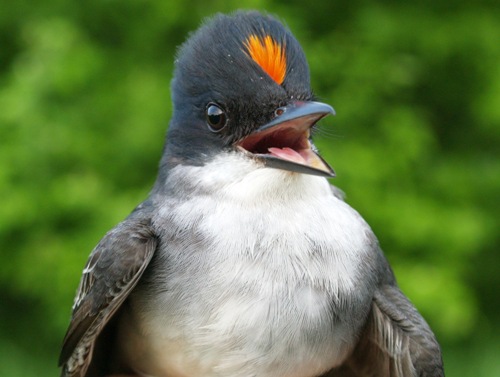|
McGILL BIRD OBSERVATORY |
|||||||||||||||||||||||||||||||||||||||||||||||||||||||||||||||||||||
Welcome
to the McGill Bird Observatory weekly report.
Click here for a complete listing of our archives.
Bander-in-charge: Simon Duval, Gay Gruner Notes: Last year we had our busiest ever first week of fall with 250 birds banded - and this year we've advanced that record slightly further with 257 over our first seven days of the season, thanks in part to great weather that allowed us to operate our full set of nets every morning. As has become tradition, one of our first two days was particularly productive, in this case 51 birds of 12 species banded on the first morning. Although some of these no doubt are local breeders or their offspring, there are always plenty of migrants this early in the season to warrant beginning our program at the start of August. Certainly the 68 species observed this week (actually below our six-year average of 71) is a far greater variety than the estimated 30-40 that breed at MBO in a typical summer, and an increase over the cumulative total of 60 species documented over the course of this summer's MAPS season (June 6 - July 31). Of course all 36 species we banded this week were new for the fall, but Veery, Swainson's Thrush, and Chipping Sparrow were our first for 2011, and we also had our first Indigo Bunting return of the year. The Swainson's Thrush continues the trend in recent years of small numbers of this species showing up at MBO long before their typical late September peak of migration, with most of these early arrivals being adults stopping over at MBO while completing their moult. Also of note, the 36 species banded this week is close to the 39 for week 1 last year, and 37 in 2009, but well above the range of 29 to 32 from 2006 to 2008 (in 2005 we had more limited banding in week 1 and only got 22 species). Although we generally don't tally our mammal sightings, the four different skunks seen on the opening round on August 4 was noteworthy - and good reason for everyone to be wide awake first thing in the morning! We also had a large wasp nest in the shed threaten to scare off some volunteers, but Matt came to the rescue to get them out.
For the sixth straight year, Yellow Warbler and Song Sparrow were the two most frequently banded species in the first week of fall. Coming out on top this year, Yellow Warbler evens the score, having also been the most abundant in 2008 and 2009, while Song Sparrow took top spot in 2006, 2007, and 2010. The count of Yellow Warblers this week was remarkable, given that the fall season total for the species has been so consistent to date, ranging between 39 and 50 annually since 2005 - so to have a new season record after just one week was quite a surprise! The previous Yellow Warbler totals for week 1 have ranged from 22 to 29, in other words around half of the season total, so if the pattern continues, we might have a chance of reaching 100 this fall. Fall numbers of American Redstart have steadily increased each year, and with 20 banded this week, the season appears off to a good start for them again. Other early warbler migrants among the top ten this week included Nashville, Tennessee, Black-throated Blue, and Common Yellowthroat. Nashville Warbler in fifth place was the biggest surprise, having only once before (2007) made the top ten this early in the season, and with fewer individuals (7) in that case. Like the Swainson's Thrushes, the Nashville and Tennessee Warblers arriving in early August are generally molt migrants showing up around 6 weeks earlier than the peak of migration for their species. After two meager years of Baltimore Oriole numbers, the 8 banded this week give us some hope that this fall might be better. Nine of the ten most abundant species in week 1 last year also made the list this year, the only difference being Red-eyed Vireo sneaking in at tenth place, replacing Indigo Bunting. However, the order of the species has shuffled a fair bit from one year to the next. Red-winged Blackbird topped this week's list, the first time since 2007 that it has dominated the first week of fall. Cedar Waxwing dropped down to second place this year, but still with numbers well above the six-year average for this time of year. Reflecting the high capture rate, Yellow Warbler vaulted up to third place among species observed this week, by far its highest rank ever for any week in fall. Song Sparrow down in ninth place is of note, since it has been in the top five for week 1 in every previous year. Although there weren't enough Tree Swallows over the course of the week to crack the top ten, the 22 individuals observed in two flocks on August 3 was a high single day count for fall. Once again fall migration is off to a great start at MBO, and we look forward to welcoming not only thousands more birds by the end of our season, but also dozens of returning and new volunteers. Please check out our volunteer section if you would like to help out, and follow our weekly reports from now through to the end of October.
|


